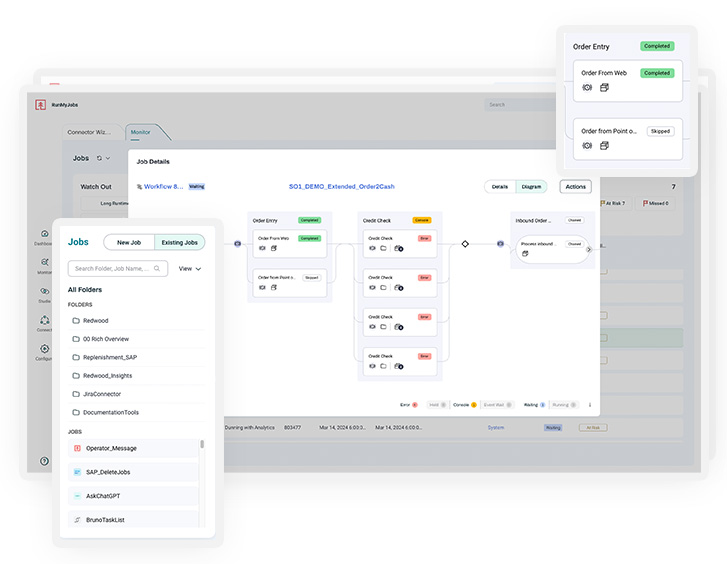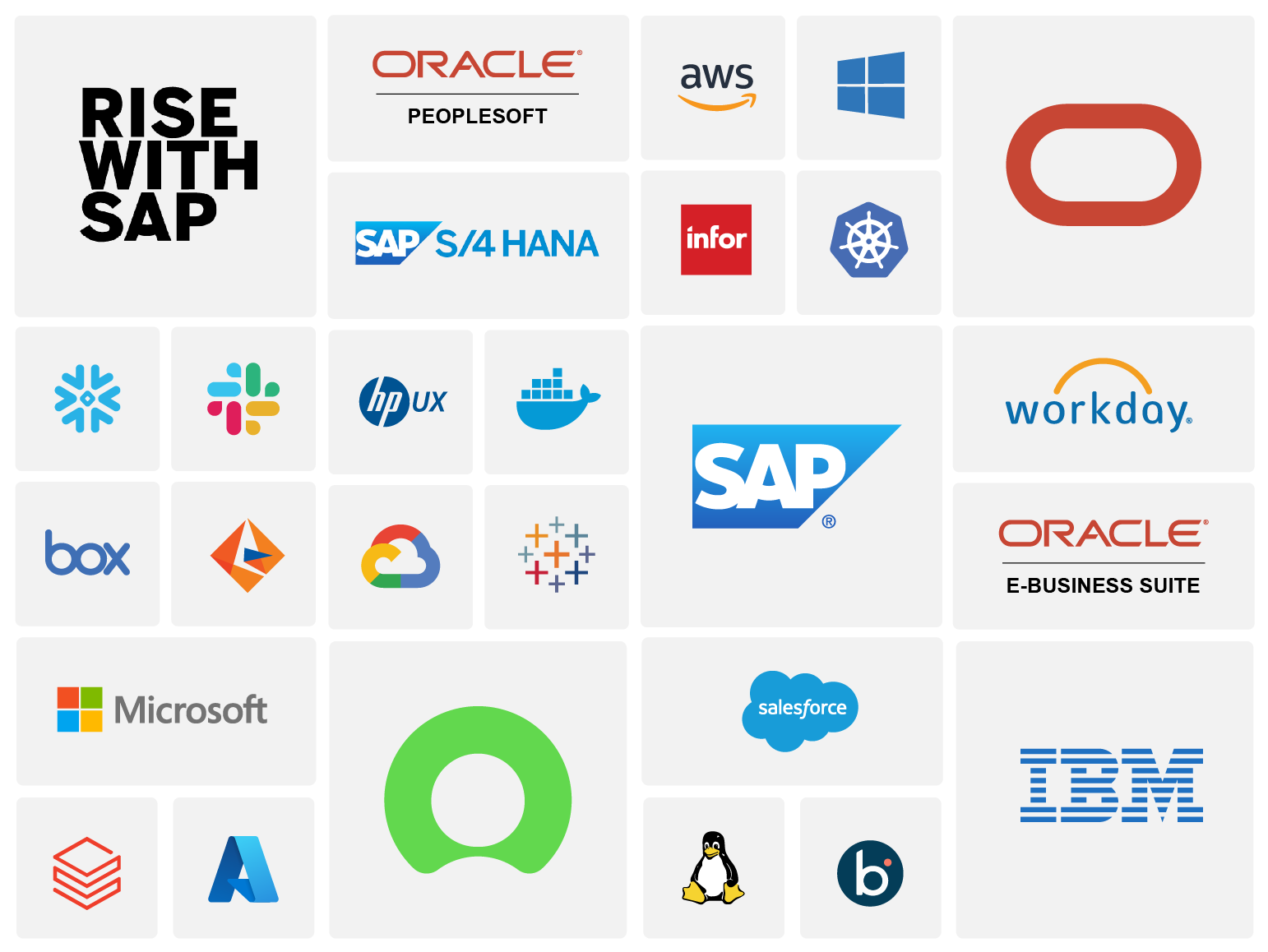Convenient self-service automation
Close the loop between human and machine in enterprise orchestration.

Empower users and customers to drive automations
Experience the ease of a layered approach to self-service automation with the user-friendly workflow design features, customization options and endless extensibility of RunMyJobs.
-
Quick bottleneck remediation
Incorporate human-in-the-loop activities for full visibility.
Keep automation jobs flowing and reduce process fragmentation with self-service options for end-users to approve, give input for and control workflows.
-
Flexible user engagement
Leverage a modular approach for precise configurations.
Enable end-users to focus only on what they need by restricting visibility, customizing navigation and enhancing the user interface with extensions.
-
Full-scale integrations
Tightly connect systems for maximum reliability.
Automate customer and employee service request fulfillment, integrate with ServiceNow or configure workflows as web services.

Accessible self-service
Self-service automation improves the customer experience by allowing end-users to start, control and influence automated processes.
With a democratized solution, your workload automation service requests can be fulfilled more quickly and accurately, and unusual situations can be handled smoothly.

Self-service automation features
RunMyJobs caters for self-service automation with a range of capabilities:
- Enable non-technical users with easy-to-use user interface customizations.
- Connect disparate systems to automate customer and business service requests.
- Gain peace of mind with comprehensive access and governance controls.
- Build bespoke solutions with extensive solution development capabilities.

Optimized performance
Avoid needless confirmation checks by integrating with file management and productivity applications to verify user actions directly.
Where a user must take action, your teams can configure forms to submit workflows and post interactive messages to approve and manage them.
Provide maximum focus by customizing the portal for specific business units or users based on configured applications, limiting links to the forms and important elements they need.

Adaptable workflows
Build a set of blueprinted workflows and configurations for business units, other teams and customers to leverage with control.
Users can apply blueprints in the visual editor to complete workflows for their functions after a few Redwood University lessons, adding specific values or configuring connections to suit their needs.
Updates to templates are easy thanks to RunMyJobs’ extensive object-based workflow configuration architecture.

Hands-on extensibility
RunMyJobs’ built-in extension technology means automation developers can create solution components to enhance the user experience and orchestrate more processes smoothly.
- Build custom user interface add-ons and tabs with extensions.
- Customize the user interface with custom toolbars, context menus and dialogs.
- Create specific servlets for third-party apps to access workflows and workflow data.
- Integrate third-party apps into RunMyJobs and retrieve data from remote systems.

First-rate governance and security
Secure and govern the platform with access controls that fit your business.
- Extend security using your enterprise standards and connect multiple SSO providers.
- Architect according to your needs with separate RunMyJobs environments.
- Segment environments with logical partitions that can be used for business units.
- Authenticate with remote systems using securely stored credentials and certificates.
- Report on all activity with comprehensive auditing and logging.

Connect RunMyJobs to ServiceNow
Enable the service desk to take action and interact with RunMyJobs by enabling the out-of-the-box bi-directional ServiceNow integration.
- Fetch ServiceNow incident information and create, automate and update in RunMyJobs.
- Create a ServiceNow incident and respond with RunMyJobs’ built-in messaging tool.
- Enable IT teams to take action by executing automations from ServiceNow.
Self service automation FAQs
What is self-service automation?
Self-service automation empowers users to complete routine tasks without human intervention. This includes functions like password resets, onboarding processes and customer support via AI-powered chatbots. By utilizing automated self-service tools, businesses can reduce the workload on IT operations and support teams, allowing them to focus on more complex tasks.
These solutions streamline business processes, improve customer satisfaction and enhance efficiency. They provide a user-friendly portal where admins and business users can access resources and perform tasks independently. Everyday use cases include IT service management (ITSM), help desk operations and DevOps activities. The benefits of self-service automation include reduced operational costs and improved service levels.
Learn more about Gartner’s workload automation trends and how self-service automation plays a role.
What is the difference between self-service and automated service?
Self-service allows users to perform tasks independently through a portal or interface. It includes accessing a knowledge base, initiating password resets or using a self-service automation portal. This approach reduces the need for desk teams to handle routine queries and manual tasks, offering real-time solutions directly to the user.
Automated service, on the other hand, involves processes that are automatically executed without user intervention. Examples include IT automation, where routine maintenance tasks are performed automatically or by IVR systems that manage calls using artificial intelligence. While both aim to improve efficiency and reduce workload, self-service focuses on empowering users, whereas automated service handles tasks behind the scenes.
Is self-service the future of services?
Self-service is becoming increasingly integral to modern service delivery. With the rise of self-service automation solutions, organizations can provide users with tools to manage tasks independently through a self-service portal. This shift improves efficiency and enhances user satisfaction by offering instant access to resources and troubleshooting options.
The growing adoption of self-service automation tools across various industries highlights its potential. Case studies demonstrate significant benefits, such as reduced operational costs and improved service metrics. As digital transformation continues, the reliance on self-service models is likely to expand, making it a key component in the evolution of service delivery.
Discover the role self-service plays in the foundation for workload automation success.